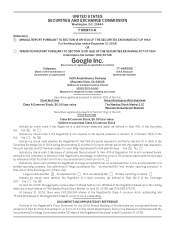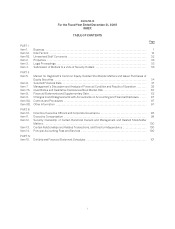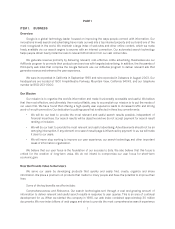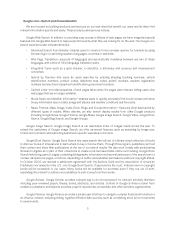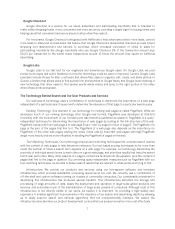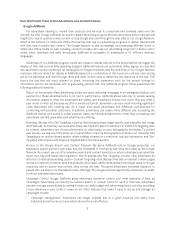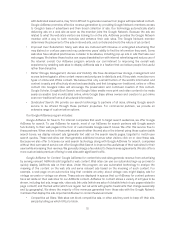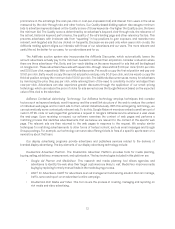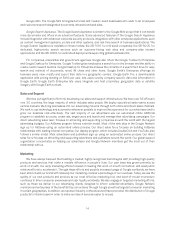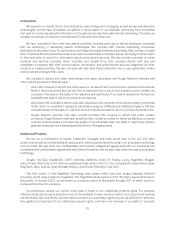Google 2008 Annual Report Download - page 23
Download and view the complete annual report
Please find page 23 of the 2008 Google annual report below. You can navigate through the pages in the report by either clicking on the pages listed below, or by using the keyword search tool below to find specific information within the annual report.Google Checkout
Google Checkout is a service for our users, advertisers and participating merchants that is intended to
make online shopping faster, more convenient and more secure by providing a single login for buying online and
helping users find convenient and secure places to shop when they search.
For merchants, Google Checkout is integrated with AdWords to help advertisers attract more leads, convert
more leads to sales and process sales. We believe that Google Checkout’s streamlined checkout process lowers
shopping cart abandonment and barriers to purchase, which increases conversion of clicks to sales for
participating merchants. We charge merchants who use Google Checkout 2% of the transaction amount plus
$0.20 per transaction to the extent these transactions exceed 10 times the amount they spend on AdWords
advertising.
Google Labs
Google Labs is our test bed for our engineers and adventurous Google users. On Google Labs, we post
product prototypes and solicit feedback on how the technology could be used or improved. Current Google Labs
examples include: Picasa for Mac, a software that allows Mac users to organize, edit, create, and share photos, In
Quotes, a feature that allows users to find quotes from stories linked to Google News, and Google Audio Indexing,a
new technology that allow users to find spoken words inside videos and jump to the right portion of the video
where these words are spoken.
The Technology Behind Search and Our User Products and Services
Our web search technology uses a combination of techniques to determine the importance of a web page
independent of a particular search query and to determine the relevance of that page to a particular search query.
Ranking Technology. One element of our technology for ranking web pages is called PageRank. While we
developed much of our ranking technology after Google was formed, PageRank was developed at Stanford
University with the involvement of our founders and was therefore published as research. PageRank is a query-
independent technique for determining the importance of web pages by looking at the link structure of the web.
PageRank treats a link from web page A to web page B as a “vote” by page A in favor of page B. The PageRank of a
page is the sum of the pages that link to it. The PageRank of a web page also depends on the importance (or
PageRank) of the other web pages casting the votes. Votes cast by important web pages with high PageRank
weigh more heavily and are more influential in deciding the PageRank of pages on the web.
Text-Matching Techniques. Our technology employs text-matching techniques that compare search queries
with the content of web pages to help determine relevance. Our text-based scoring techniques do far more than
count the number of times a search term appears on a web page. For example, our technology determines the
proximity of individual search terms to each other on a given web page, and prioritizes results that have the search
terms near each other. Many other aspects of a page’s content are factored into the equation, as is the content of
pages that link to the page in question. By combining query independent measures such as PageRank with our
text-matching techniques, we are able to deliver search results that are relevant to what people are trying to find.
Infrastructure. We provide our products and services using our homegrown software and hardware
infrastructure, which provides substantial computing resources at low cost. We currently use a combination of
off-the-shelf and custom software running on clusters of commodity computers. Our considerable investment in
developing this infrastructure has produced several benefits. This infrastructure simplifies the storage and
processing of large amounts of data, eases the deployment and operation of large-scale global products and
services, and automates much of the administration of large-scale clusters of computers. Although most of this
infrastructure is not directly visible to our users, we believe it is important for providing a high-quality user
experience. It enables significant improvements in the relevance of our search and advertising results by allowing
us to apply superior search and retrieval algorithms that are computationally intensive. We believe the
infrastructure also shortens our product development cycle and lets us pursue innovation more cost effectively.
7


